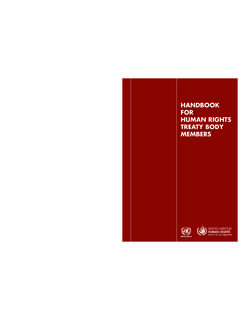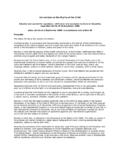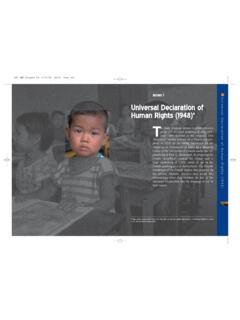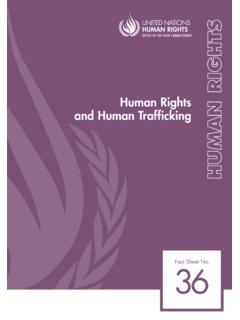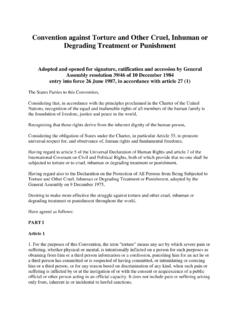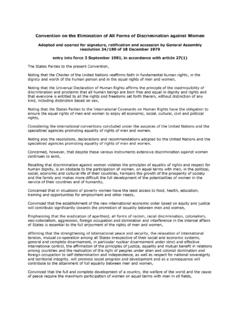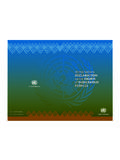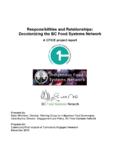Transcription of Indigenous Peoples and the United Nations …
1 9 Indigenous Peoples and the United NationsHuman rights SystemFact Sheet Peoples and the United Nations Human rights SystemFact Sheet No. 9 Nations New York and Geneva, 2013 IINOTEThe designations employed and the presentation of the material in this pub-lication do not imply the expression of any opinion whatsoever on the part of the Secretariat of the United Nations concerning the legal status of any country, territory, city or area, or of its authorities, or concerning the delimita-tion of its frontiers or boundaries.** *Symbols of United Nations documents are composed of capital letters com-bined with figures. Mention of such a figure indicates a reference to a United Nations AND ABBREVIATIONS.
2 IVINTRODUCTION .. 1 ChaptersIII. Indigenous Peoples rights .. 4A. The United Nations Declaration on the rights of Indigenous Peoples .. 4B. ILO Convention concerning Indigenous and Tribal Peoples in Independent Countries, 1989 (No. 169) .. 9C. Regional and domestic application of the rights of Indigenous Peoples .. 9 III. INTERNATIONAL INSTITUTIONAL INFRASTRUCTURE .. 11A. United Nations human rights system .. 11B. Bringing human rights issues to the United Nations .. 23 III. OFFICE OF THE United Nations HIGH COMMISSIONER FOR HUMAN rights .. 27A. United Nations High Commissioner for Human rights .
3 27B. Office of the United Nations High Commissioner for B. Human 27C. Cooperation at the United Nations on Indigenous Peoples issues .. 30IV. REGIONAL HUMAN rights SYSTEMS .. 33A. African Commission on Human and Peoples rights .. 33B. Organization of American States .. 34C. Council of Europe and European Court of Human rights .. 35IV. OTHER United Nations AGENCIES AND INTERNATIONAL BODIES WORKING ON Indigenous Peoples ISSUES .. 36 Further reading .. 41 IVAcronyms and abbreviationsASEAN Association of Southeast Asian NationsFAO Food and Agriculture Organization of the United NationsIFAD International Fund for Agricultural DevelopmentILO International Labour OrganizationOAS Organization of American StatesOHCHR Office of the United Nations High Commissioner for Human RightsUNDP United Nations Development ProgrammeUNEP United Nations Environment ProgrammeUNESCO United Nations Educational.
4 Scientific and Cultural OrganizationUNFPA United Nations Population FundUN-Habitat United Nations Human Settlement ProgrammeUNICEF United Nations Children s FundUNITAR United Nations Institute for Training and ResearchUN-Women United Nations Entity for Gender Equality and the Empowerment of WomenUPR universal periodic reviewWHO World Health OrganizationWIPO World Intellectual Property Organization1 INTRODUCTIONThe rights of Indigenous Peoples have, over the past three decades, become an important component of international law and policy, as a result of a movement driven by Indigenous Peoples , civil society, international mecha-nisms and States at the domestic, regional and international levels.
5 The Unit-ed Nations human rights system its mechanisms, laws and policies have been at the heart of these developments with bodies such as the United Na-tions Working Group on Indigenous Populations playing a groundbreaking role, which is continued by the Human rights Council and its mechanisms, in cooperation with other key actors, including the United Nations Permanent Forum on Indigenous Issues. One of its main achievements was the General Assembly s adoption in 2007 of the United Nations Declaration on the rights of Indigenous Peo-ples, which, by 2010, was supported by the vast majority of United Na-tions Member States and opposed by none.
6 It was the result of decades of negotiation between States and Indigenous Peoples , coming together in a spirit of partnership to endorse the Indigenous Declaration. It applies human rights to Indigenous Peoples and their specific situations, thereby helping to reverse their historical exclusion from the international legal system. International activity on Indigenous Peoples issues has been expanding also in regional human rights bodies, such as the African and inter-American hu-man rights systems, and into international law and policy areas as diverse as the environment (including climate change), intellectual property and Fact Sheet provides a reader-friendly overview of the United Nations human rights system and the rights of Indigenous Peoples .
7 It is designed to give readers: A summary of Indigenous Peoples rights ; An overview of the international human rights bodies and mecha-nisms in relation to Indigenous Peoples ; A description of the activities of the Office of the United Nations High Commissioner for Human rights (OHCHR) related to Indigenous peo-ples; A brief summary of relevant regional human rights systems as they engage with Indigenous Peoples and protect their human rights ; and A summary of some United Nations agencies, beyond the human rights framework, engaged in Indigenous Peoples Fact Sheet also refers to further sources of information.
8 2 Who are Indigenous Peoples ? Indigenous Peoples live on all continents, from the Arctic to the Pacific, via Asia, Africa and the Americas. There is no singularly authoritative definition of Indigenous Peoples under international law and policy, and the Indig-enous Declaration does not set out any definition. In fact, its articles 9 and 33 state that Indigenous Peoples and individuals have the right to belong to an Indigenous community or nation, in accordance with the traditions and customs of the community or nation concerned, and that they have the right to determine their own identity. The International Labour Organization s (ILO) Convention concerning Indigenous and Tribal Peoples in Independent Countries (No.)
9 169) distinguishes between tribal and Indigenous Peoples as follows, highlighting also the importance of self-identification:1.. (a) Tribal Peoples in independent countries whose social, cultural and economic conditions distinguish them from other sections of the national community, and whose status is regulated wholly or partially by their own customs or traditions or by special laws or regulations;(b) Peoples in independent countries who are regarded as Indigenous on account of their descent from the populations which inhabited the country, or a geographical region to which the country belongs, at the time of conquest or colonization or the establishment of present State boundaries and who, irrespective of their legal status, retain some or all of their own social, economic, cultural and political Self-identification as Indigenous or tribal shall be regarded as a fundamental criterion for determining the groups to which the provisions of this Convention the lack of an authoritative definition.
10 There are criteria that help to define Indigenous Peoples . The main one is the criterion of self-identification and those proposed by Jos Mart nez Cobo in his Study of the problem of discrimination against Indigenous populations ,1 which include: Historical continuity with pre-invasion and/or pre-colonial societies that developed on their territories; Distinctiveness; Non-dominance; and A determination to preserve, develop and transmit to future genera-1 and Adds. 1 their ancestral territories and identity as Peoples in accordance with their own cultural patterns, social institutions and legal United Nations Permanent Forum on Indigenous Peoples has stressed, in addition to the above: A strong link to territories and surrounding natural resources; Distinct social, economic or political systems.


